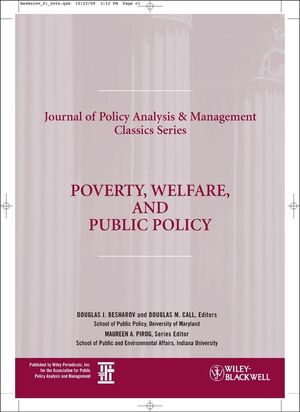Poverty, Welfare, and Public PolicyISBN: 978-1-4443-3513-2
Paperback
April 2010, Wiley-Blackwell
 |
||||||
The measure and meaning of poverty.
How to Improve Poverty Measurement in the United States, Rebecca Blank (2008).
Reconciliation of Income and Consumption Data in Poverty Measurement, Richard Bavier (2008).
The Relationship Between Income and Material Hardship,James X. Sullivan, Lesley Turner, and Sheldon Danziger (2008).
The Occurrence of Poverty Across the Life Cycle: Evidence from the PSID, Mark Rank and Thomas Hirschl (2001).
A Re-Examination of Welfare States and Inequality in Rich Nations: How In-Kind Transfers and Indirect Taxes Change the Story, Irwin Garfinkel, Lee Rainwater, and Timothy Smeeding (2006).
The demographics of poverty.
For Richer or for Poorer: Marriage as an Anti-Poverty Strategy, Adam Thomas and Isabel Sawhill (2002).
Black Employment Problems: New Evidence, Old Questions, Harry Holzer (1994).
Declining Employment Among Young Black Less-Educated Men: The Role of Incarceration and Child Support, Harry Holzer, Paul Offner, and Elaine Sorensen (2005).
Labor Market Experiences of Low-Income Black Women in Middle-Class Suburbs: Evidence from a Survey of Gautreaux Program Participants Susan Popkin, James Rosenbaum, and Patricia Meaden (1993).
Moving Into and Out of Poor Urban Areas,Edward Gramlich, Deborah Laren, and Naomi Sealand (1992).
2. The Road to Welfare Reform.
Welfare dependency.
Determinants of Initial Entry onto Welfare by Young Women, Marieka Klawitter, Robert D. Plotnick, and Mark Evan Edwards (2000).
The Interaction between Single Mothers' Living Arrangements and Welfare Participation," Rebecca London (2000).
Moving Up, Moving Out, or Going Nowhere? A Study of the Employment Patterns of Young Women and the Implications for Welfare Mothers, LaDonna Pavetti and Gregory Acs (2001).
Mandatory vs. voluntary programs.
Welfare Reform and Mandatory Versus Voluntary Work: Policy Issue or Management Problem? Mary Jo Bane (1989).
Should Workfare be Mandatory? What Research Says," Lawrence Mead (1990).
Rejoinder to Mead, Laurence Lynn (1990).
Can a Voluntary Welfare Program Change the Behavior of Welfare Recipients? New Evidence from Washington State's Family Independence Program (FIP)," Duane Leigh (1995).
Four decades of experimentation.
Fostering Research Excellence and Impacting Policy and Practice: The Welfare Reform Story, Judith Gueron (2003).
Demonstration Evaluations and Cost Neutrality: Using Caseload Models to Determine the Federal Cost Neutrality of New Jersey's REACH Demonstration, Steven Garasky and Burt Barnow (1992).
The Budgetary Implications of Welfare Reform: Lessons from Four State Initiatives," David Long (1988).
3. TANF and Its Aftermath.
Did welfare reform "succeed"?
Alternative Measures of Economic Success among TANF Participants: Avoiding Poverty, Hardship, and Dependence on Public Assistance, Maria Cancian and Daniel Meyer (2004).
Why Welfare Reform Succeeded, Lawrence Mead (2007a).
TANF's Results are More Mixed than is Often Understood, Sharon Parrott and Arloc Sherman (2007a).
Response to Parrott and Sherman, Mead (2007b).
Response to Mead, Parrott and Sherman (2007b).
Welfare vs. work.
Incentives, Challenges, and Dilemmas of TANF: A Case Study, Barbara Wolfe (2002).
Does It Pay to Move From Welfare to Work?, Sheldon Danziger, Colleen M. Heflin, Mary E. Corcoran, Elizabeth Oltmans, and Hui-Chen Wang (2002).
Does it Pay to Move From Welfare to Work? A Comment on Danziger, Heflin, Corcoran, Oltmans, and Wang, Robert Moffitt and Katie Winder (2005).
Does It Pay to Move from Welfare to Work? Reply to Robert Moffitt and Katie Winder, Sheldon Danziger and Hui-Chen Wang (2005).
Child support and father's work.
Child Support Enforcement: Programs and Policies, Impacts and Questions, Maureen Pirog and Kathleen Ziol-Guest (2006).
Effective Child Support Policy for Low-Income Families: Evidence From Street Level Research, Maureen Waller and Robert Plotnick (2001).
4. How Much Does Research Matter?
Congress Writes a Law: Research and Welfare Reform, Haskins (1991).
Expertise, Advocacy, and Deliberation: Lessons from Welfare Reform,Mary Jo Bane (2001).
The Dissemination and Utilization of Welfare-to-Work Experiments in State Policymaking, David Greenberg, Marvin Mandell, and Matthew Onstott (2000).
Conclusion.
From the Great Society to Continuous Improvement Government: Shifting from ‘Does it Work?' to ‘What Would Make it Better?' Douglas Besharov.



